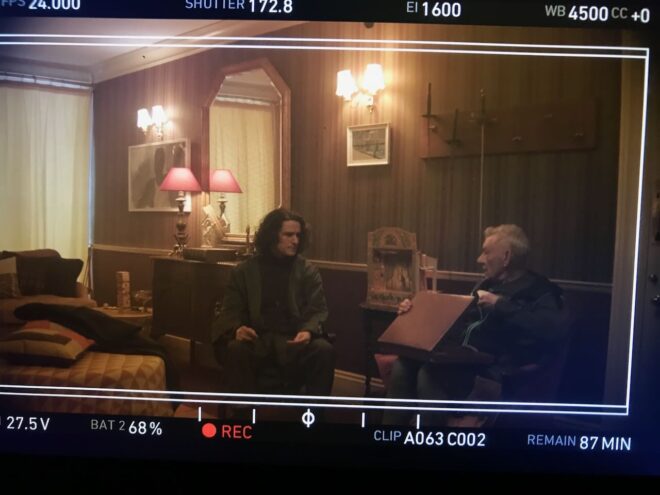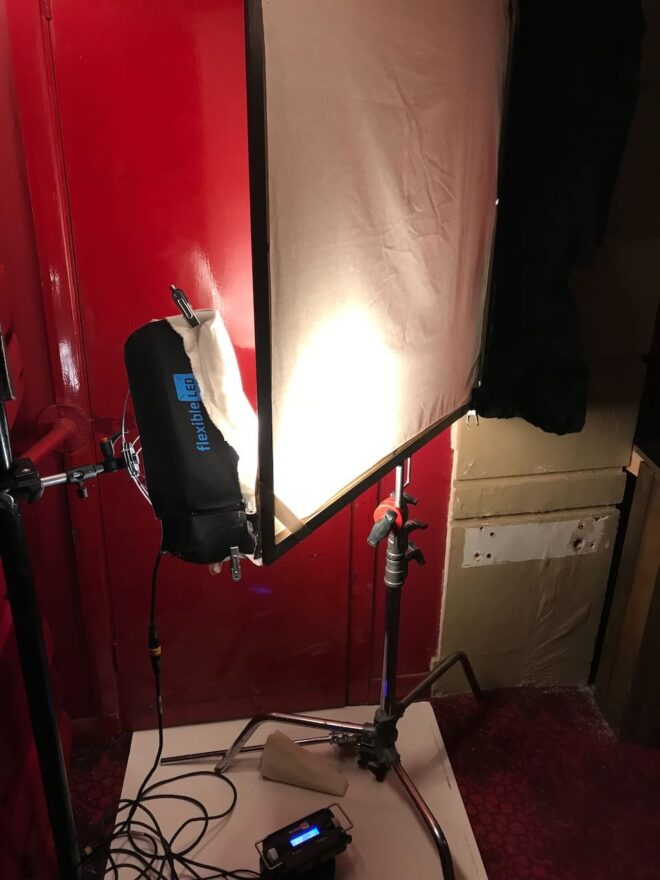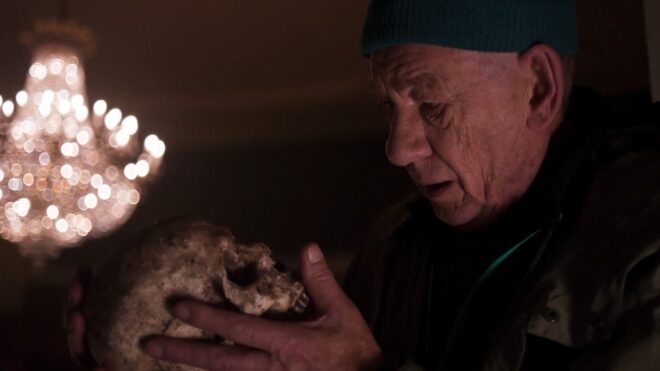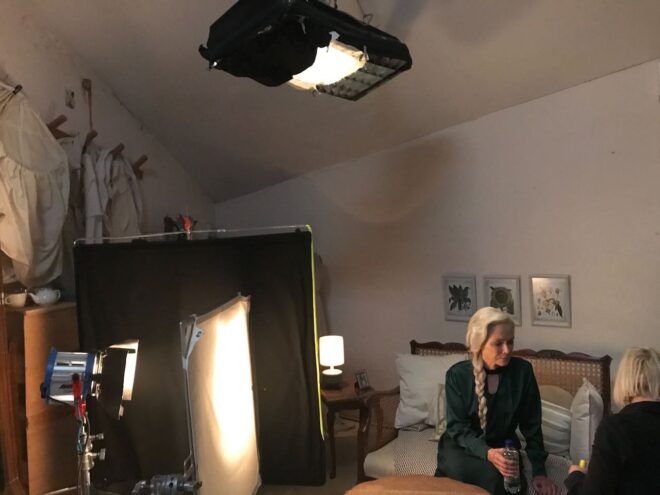Day 18 – 26/4/21
“Alack and fie for shame”
Today’s material involved Ophelia seeking audience with Gertrude, then singing a risqué song to both her and the king. It sounds very simple when I type it out like that, but somehow it still took all day and wasn’t as well covered as I would have liked. (We did take a short break from the sequence, while waiting for hair and make-up, to grab a couple of actor-less shots of monitors playing the King’s speech from day 7.) There were a lot of big wides and very telephoto shots lensed on the zoom, due to Gertrude being in the circle and the others being in the stalls and on the stage for much of the sequence. Ben used a Source Four to key her, a very hard source but we got away with it by allowing it to mix with the existing house practicals. Zoe came up with some rock-’n’-roll lighting for the song, and Ben worked with her to tweak it for camera. This lighting was predominantly blue which was a colour I originally didn’t want in the film at all (at least not a colour of light), but it’s already crept in a couple of times, so I’ve given up fighting it! When the King and Queen stood in the stalls at the edge of the stage, Ben used a diffusion frame to bring down the intensity of the stage lighting and soften it off. When the pair sit down they were primarily lit by a 2K bounced off poly, with the house lights filling in. For the most aggressive part of the song I circled Ophelia, handheld and low, getting lots of flare off the backlights and the follow spot.
Day 19 – 27/4/21
“Get thee to a nunnery”
We shot a sequence of three scenes on the stage and in the vomitorium where we’d shot Gertrude back on day 2. As we were working mostly with two cameras, Ben advised me against the hard, shadowy lighting through the metalwork of the set that I initially envisaged, and instead went for a soft source achieved by firing a 5K into an Ultrabounce up on the bridge. A Litemat armed out from the back of the bridge helped to wrap this source into a backlight for certain positions. We put on just one of the set’s florries, the bulkheads on the back wall and the odd other source from the grid, but Zoe had a pretty easy day!
When we got onto the material in the vom, Ben managed to bounce a tungsten fresnel (1K, I think) through unbleached muslin and mix it with Astera tubes to produce a soft light that would strike Hamlet from an edgy, “broken key” angle, motivated by the single ceiling bulb. On Ophelia’s reverse we went for a lower angle, as if it was floor bounce, because a more sidey look seemed too glamorous for the mood of the scene. For composition, heavy short-siding and occluding foreground objects were the orders of the day.
At the end of the day we picked up a dropped shot from day 3 before returning to the paint shop one last time to complete scene 18.
Day 20 – 28/4/21
“Alas, poor Yorick”
First up was a scene in the foyer, a new space of us to film in, with Hamlet acting mad to Polonius. It was a scene whose storyboards I wasn’t very happy with, but I managed to find a new position for the wide – still starting with a zoom out from the convex mirror as planned – which made things a bit more interesting. On the spur of the moment I sent Max into the box office with B-cam, and he got a voyeuristic shot through the closed fretwork of the shutter, in which we captured Polonius’ asides. Reflections were a bit of a nightmare for the wide, not just because of the convex mirror but because of normal mirrors in the frame, glass in the doors and even a mirror behind camera (as seen in the doors). Lighting was pretty simple, just a Jem ball boomed overhead, the windows above the outer doors blacked out to suggest night, and a couple of Asteras between the inner and outer doors producing Urban Sodium spill. A couple of handheld set-ups were all that were necessary to complete the scene.
The next scene – featuring the famous Yorick skull – was a very different set-up. Hamlet and Horatio were in an upper box talking to the gravedigger (Llinos) on the stage below. Trying to communicate with other cast and crew on different levels of the building always slows things down, as did attempting to make things work for two cameras. (After struggling for quite a while to make the lighting work for both a wide and a 2-shot, it turned out that we couldn’t roll them both together anyway because of sound issues.) To match with the gravedigger material from day 6, we needed a soft, blue-ish three-quarter backlight, which was a 5K tungsten bounce again up on the bridge of the set. The usual Asteras behind the bleachers were set to a cool temperature too. Hamlet and Horatio in the box were lit by two more Asteras and a Fomex, all motivated by a practical table lamp. To key them from the front, a Source Four was aimed at them from beside the 5K, and cut and dimmed to make it as subtle as possible. Eliminating shadows from a theatre speaker rigged near the box was somewhat time-consuming. Next we shot Llinos, both from the box and from stage level simultaneously, and as on day 6 we beefed up her practical worklight with a Rifa. We also hid another Astera inside the grave, and turned on the footlights to help her too.
Day 21 – 29/4/21
“I pray you, be round with him!”
A big scene today in the costume workshop at the very top of the theatre, beautifully dressed as always by Lee’s team. The room has a lovely skylight which sadly we had to black out because it’s a night scene. Ben put up a polecat across it and rigged a Litemat 2L to it, with another one attached to an existing hanging fluorescent above a sitting area. (We didn’t use any of the fluorescents.) On the other side of the room Ben rigged more polecats with a series of three Astera tubes set to 4000K for a slightly cooler look than the tungsten we were going for in the rest of the space. Then it was just a case of dimming the various practical table lamps and lighting the candles! Some key parts of the action take place around and behind a rack of costumes where Polonius hides to spy on Hamlet, and ultimately meets his death at the prince’s hands. We made sure to establish a practical behind there, then used a Fomex and another Astera covered in muslin to wrap and “floor bounce” this where necessary. Unfortunately, to few people’s surprise, we didn’t finish the scene.
Day 22 – 30/4/21
“There is a divinity that shapes our ends, rough hew them as we will”
We spent most of the day completing the costume workshop scene, bringing in Francesca Annis late morning for her ghost shots. We repeated the green Northern Lights effect from the roof in the side room where the ghost appears, and took care not to fill the room with too much “ordinary light”. Another Astera was mounted above the door which Francesca looked through, top-lighting her, but we had to flag it to stop it spilling into the room.
With only about an hour and a half left of our day, we moved to the follow-spot booth to shoot a small scene which we had dropped on Wednesday. We had to make this pretty basic, two shot sizes from one direction and one size from the other. The existing florry was used as motivation, with Asteras enhancing.
Day 23 – 1/5/21
“Do you know this waterfly?”
A big day in Hamlet’s dressing room, a club room on the ground floor of the theatre that the art department had dressed to look like a seventies teenager had taken over his grandad’s bedroom! Very appropriate for an age-blind Hamlet. The first scene was broad daylight, and Ben rigged a 12×12 Ultrabounce outside which served to block traffic and pedestrians from the camera’s view and to flag the real sun, and of course as a medium to bounce artificial light into, specifically a 6K HMI fresnel. With the net curtains on the window, we had a lovely big, soft source to backlight our wide shot from the opposite end of the room. We turned off the wall sconces – I wasn’t sure, but Ben talked me into it, and he was right! – but had a few practical table lamps on, one of which served perfectly to give a side-light on Ian. The only things we added to the wide were an Astera on the floor for eye-light, and another tucked outside the door to ensure that Horatio and Marcellus were sufficiently lit when Hamlet lets them in. For Ian’s close-up we used a tungsten fresnel through a muslin frame to replace the practical, and turned down the 6K to reduce the veiling lens flare from the window. (The anti-flare coatings on the Cooke Panchros is poor by modern standards, but that’s one of the things I love about them.) For Ben and Ashleigh’s singles the window was a beautiful key and needed only a little bounce to augment it.
 After lunch we moved onto a scene much, much later in the story, in which Hamlet and Horatio discuss the morality of killing Claudius, then Osric arrives to tell them of the proposed duel. Sean and I had agreed in rehearsals that the outer curtains should be closed for this scene, giving the room a beautiful yellow glow. Just before we rolled on the first set-up, however, Sean expressed concern about how bright the window looked, preferring to give more of an evening feel to the scene. We wasted off the 6K, leaving mostly just natural light to backlight the curtains, making the wall scones and practicals feel like the main sources. Ben bounced a small fresnel off the ceiling to fill in the faces. I shot the whole scene on the Cinetal, thinking I might add in an unplanned zoom to one or more of the set-ups, but in the end I didn’t. When we moved to Hamlet’s close-up, and needed to pull focus from a foreground letter in Horatio’s hands, we broke out the dioptres for the first time in order to focus close enough. This meant we had to cheat Hamlet slightly closer to the lens so that we wasn’t beyond the new maximum focal distance. Our final set-ups of the scene were POVs through the door’s spy-hole when Hamlet first sees Osric at the door. I thought there might be some experimentation involved to find a lens that allowed us to get close enough for the spy-hole to be large enough in frame, but still to focus on someone fairly close on the other side. I decided to try the 50mm first – they’re usually best for close focus and versatility – and it worked out perfectly. We took off the matte box and pushed the lens right up to the spy-hole, with just enough room for me to squeeze in my finger and open the spy-hole’s cover on cue.
After lunch we moved onto a scene much, much later in the story, in which Hamlet and Horatio discuss the morality of killing Claudius, then Osric arrives to tell them of the proposed duel. Sean and I had agreed in rehearsals that the outer curtains should be closed for this scene, giving the room a beautiful yellow glow. Just before we rolled on the first set-up, however, Sean expressed concern about how bright the window looked, preferring to give more of an evening feel to the scene. We wasted off the 6K, leaving mostly just natural light to backlight the curtains, making the wall scones and practicals feel like the main sources. Ben bounced a small fresnel off the ceiling to fill in the faces. I shot the whole scene on the Cinetal, thinking I might add in an unplanned zoom to one or more of the set-ups, but in the end I didn’t. When we moved to Hamlet’s close-up, and needed to pull focus from a foreground letter in Horatio’s hands, we broke out the dioptres for the first time in order to focus close enough. This meant we had to cheat Hamlet slightly closer to the lens so that we wasn’t beyond the new maximum focal distance. Our final set-ups of the scene were POVs through the door’s spy-hole when Hamlet first sees Osric at the door. I thought there might be some experimentation involved to find a lens that allowed us to get close enough for the spy-hole to be large enough in frame, but still to focus on someone fairly close on the other side. I decided to try the 50mm first – they’re usually best for close focus and versatility – and it worked out perfectly. We took off the matte box and pushed the lens right up to the spy-hole, with just enough room for me to squeeze in my finger and open the spy-hole’s cover on cue.
During the afternoon, Max and the lighting crew had been setting up B-cam ready for a pick-up shot of Horatio reacting to the “Alas, poor Yorick” speech, something we dropped on Wednesday, but we ended up shooting it on A-cam instead.




